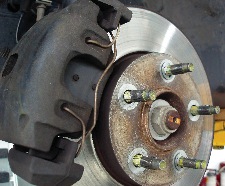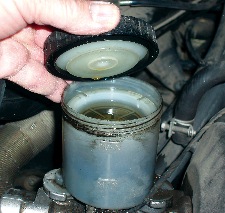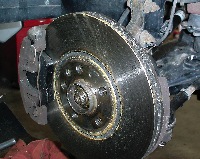Unfortunately, many shops are not making as much profit as they should on brake replacements. Some are losing money by using brake replacements as “loss leaders” in their marketing and depending upon “up-sells” to restore profitability to their brake service revenues. With these facts in mind, we need to occasionally analyze and re-evaluate how we package and price brake friction replacements. To illustrate the basic process, I will be using some representative product pricing and labor time numbers.

SHOP TIME
At the outset, it’s important to understand that an equal amount of shop time is required to install an “entry-level” set of brake pads as it does a “premium” set of pads. A major labor guide, for example, quotes a brake inspection at 0.6 hours for a 2002 Toyota 4Runner. Replacing the front pads requires one hour. An on-car disc rotor refinish is 1.0 hours for both rotors. Bleeding or flushing the system is quoted as “combination time” of an additional 0.2 hours. Altogether, the flat-rate time for an average front brake service adds up to 2.8 hours.
When 2.8 hours is multiplied by an average hourly rate of, let’s say, $70 per hour, the gross labor profit equals $196. If the tech has the job out the door in 2.0 hours, the hourly gross profit increases to $98. Because a net profit calculation depends upon variables like shop efficiency and technician productivity, the shop might be making or losing money on that $98 per hour gross profit.

BRAKE FRICTION MATH
As the saying goes, “It’s all in the math.” If you’re a little short in the math department, you can buy a small business calculator for about $10 at your local discount store or you can enter the desired profit margin into your business management system. The small calculator often works best because it forces you to think about how the math works.
To illustrate the math, a local jobber store can supply up to five different grades of front brake friction with the prices ranging from $13 to $70 at wholesale cost. To determine profit margin on a small business calculator, enter $13 under “cost” and then enter your profit desired margin (40%) to produce a retail price for the entry-level brake pad of $21.67. At a 40% profit margin, the entry pad contributes $8.67 to the repair order gross profit. The same calculation on a premium pad contributes $46.67 to the gross profit, plus the premium pads often include the shims, grommets and lubricants needed for correct installation. Our brake friction math, therefore, indicates that selling the premium pad is at least 500% more profitable than selling the “entry-level” pad.
THE COMEBACK FACTOR
Most short-term brake service comebacks revolve around brake squeal, brake dusting and pedal response complaints. To illustrate the extreme ends of the brake friction spectrum, let’s pretend that the premium pad generates 0% comebacks while the entry pad generates 25% comebacks. Due to the comeback factor, the real-world cost of the entry pad jumps from $13 to $16.25. A 25% comeback on the entry pad also reduces the original $196 labor profit by 25% to $147. Due to the comeback factor, the entry pad can cost more money to install than the premium pad.
SELECTING BRAKE FRICTION
Selecting brake friction is perhaps one of the most controversial issues in the independent service sector. In the past, edge codes were used to determine brake wear and heat-fade characteristics of various brake friction materials. (If you want to learn more about edge codes, enter “brake edge codes” into the search box at www.brakeandfrontend.com) While edge codes are still a valid method of comparison, more subjective factors such as noise level and brake dusting now enter into the selection of brake friction material.
Due to sourcing, climate and driving condition factors, no single friction choice addresses all concerns. A rural shop might rely on aftermarket brake friction, whereas a metro shop might rely on OE friction. A brake pad also functions differently in hot, cold, humid and arid climates. Last, a minor brake squeal that might be very noticeable in metro driving is easily ignored in rural driving.
In general, brake friction falls into six general categories: non-asbestos organic (NAO), semi-metallic, ceramic organic, full ceramic, sintered metal and carbon fiber. The first three compounds are designed for normal use, while the last three compounds are designed for exotic, high-performance and high-end use.
NAO compounds generally use carbon, Kevlar or other synthetic fibers as friction components, while ceramic organics incorporate varying amounts of ceramic powder to modify friction characteristics. Semi-metallic brake friction incorporates steel fibers to achieve its aggressive braking characteristics.
NAO pads generally produce less braking power, wear and high-temperature performance than ceramic organic or semi-metallic friction. Semi-metallic friction generally wears rotors faster, but produces more aggressive braking performance with less pedal fade. The downside of semi-metallic friction is extremely bad wheel dusting and poor or uneven cold pedal response. Ceramic organics are popular on current production vehicles because they offer less dusting and better general overall performance than NAO or semi-metallic friction.
Because each friction manufacturer blends compounds for specific characteristics, the distinctions between these categories can be blurred. So a shop might find that one brand or type of pad works better for heavy-duty recreational truck use, while other types of friction might be more resistant to squealing caused by dust, humidity or water in normal passenger car use.
PACKAGING BRAKE SERVICES FOR PROFIT
The key to profitability in brake services is packaging those services into cost-effective units that will meet the needs of your customer base. Cutting corners generally results not in profits, but excessive comebacks. As I mentioned above, a 25% comeback rate results in a 25% decrease in gross profits, regardless of the packaging.
I don’t want to engage in the debate over the need to resurface or replace brake rotors or calipers as an integral part of any brake service in this space. But, according to my experience, a thorough rotor resurfacing, including cleaning or outright replacement, generally produces fewer comebacks and more profitable results than does a pad replacement. Because current production rotors have so little tolerance for machining, many shops find that rotor replacement is more cost-effective than rotor service. Similarly, any shop located in a rust-belt area will generally find it more profitable to include remanufactured brake calipers in its brake service packages.
But let’s compare labor rates between a minor and major brake service. A pad replacement and rotor service generally requires 2.8 hours. On the other hand, caliper replacements average 1.4 hours for both front brakes, while replacement of both front disc rotors is quoted at 1.0 hours. From a packaging standpoint, the labor rates for both service packages are nearly the same. In addition, the shop is not only making good profit margins on the new brake calipers and rotors, it will see less cost in the form of warranty comebacks.

IT’S ALL IN THE MATH
Integrating a particular brake friction material into a brake service packaging formula is, in my point of view, a mathematical exercise. The ultimate outcome, of course, is the hourly gross profit a brake service should generate. Mathematically speaking, the “entry” pad produces much less profit and more potential costs in the form of comeback complaints than does the premium pad. But, from a marketing standpoint in today’s tough economy, something might be said for using a mid-grade friction material in some applications. In any case, take a few minutes to do the math before you try to make the sale.













